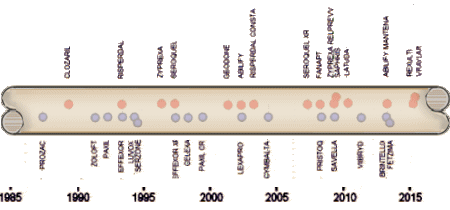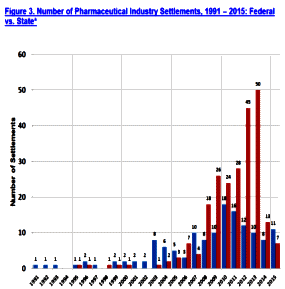Major Depressive Disorder [MDD] is a term that originated in the DSM-III in 1980 as a descriptive diagnosis, a fix for perceived difficulties with the previous diagnostic system. It replaced a number of previous diagnoses that its author, Robert Spitzer, thought could not be clearly discriminated – things like depressive neurosis, the melancholic depressions, involutional depression, post-partum depression, etc. It was intended to be a category that would be separated into more clearly distinct syndromes over time. But that’s not at all what happened.
In 1987, the approval of Prozac introduced a new class of antidepressant drugs, consolidating the "medicalization" of psychiatry, opening a pipeline of new psychiatric drugs. The DSM-IV [1994] made no substantive change to the diagnosis of Major Depressive Disorder, though it had begun to be talked about as a brain disease. The third party carriers adapted payment schedules to reimburse psychiatrists for medication management only in a system known as managed care. And the era of the 1990s was officially declared to be the Decade of the Brain with a flurry of neuroscience research. Psychiatric medications aimed for the top of the sales charts.

 And as the SSRIs were only effective in a third to a half of people with the MDD diagnosis, a new disease was born – Treatment Resistant Depression [TRD]. Then came multiple schemes trying to improve the SSRIs track record, one of which was augmentation with the other new class of drugs, the Atypical Antipsychotics. But the decade didn’t end like it started as the specialty was rife with scandal – Senator Grassley’s exposure of financial corruption among academic psychiatrists in 2008 and a flurry of civil and criminal suits against pharmaceutical companies for a variety of misbehaviors leading to even more exposure.
And as the SSRIs were only effective in a third to a half of people with the MDD diagnosis, a new disease was born – Treatment Resistant Depression [TRD]. Then came multiple schemes trying to improve the SSRIs track record, one of which was augmentation with the other new class of drugs, the Atypical Antipsychotics. But the decade didn’t end like it started as the specialty was rife with scandal – Senator Grassley’s exposure of financial corruption among academic psychiatrists in 2008 and a flurry of civil and criminal suits against pharmaceutical companies for a variety of misbehaviors leading to even more exposure.And things haven’t gone so well in the current decade either. The pipeline was drying up for new drugs and in 2012 it became apparent that PHARMA was shutting down its CNS R&D programs altogether. The suits and scandal exposures continued. The Clinical Neuroscience initiative at the NIMH had gone nowhere and the DSM diagnostic system was abandoned there altogether for an inchoate RDoC system-maybe-to-be. The DSM-5 hopes for biologically based diagnoses were dashed by lack-of-discovery, and it was released with the same tired MDD diagnosis, little changed from the DSM-III of 1980. But in spite of expiring patents and everything else, the psychiatric drugs remain near the top of the charts.
PharmExec.comBy Pharmaceutical Executive EditorsOct 24, 2016The US market for major depressive disorders [MDD] will rise from $2.4 billion in 2015 to $4.6 billion by 2025, at an compound annual growth rate of 6.6%, according to GlobalData. The company’s report states that the US will not only remain the largest major market for MDD drugs, but will extend its lead over other countries, primarily due to the wide-ranging availability of treatments and the commercial success of atypical antipsychotics, which generated 39% of the sales in the US market in 2015.
GlobalData analyst Christos Michaelides, Ph.D., commented: “As a class, atypical antipsychotics are due to retain their market share during the forecast period and are expected to generate sales of $1.9 billion in 2025, which will represent a little over two-fifths of the US MDD market… While Abilify generated the greatest revenue for the atypical antipsychotics in 2015, its sales will remain static during the forecast period. This will be due to increasing use of generic aripiprazole, and competition from Otsuka/Lundbeck’s Rexulti, which is due to see its US sales increase rapidly to just under $588 million by 2025.”
GlobalData estimates that five products in the late-stage pipeline will enter the MDD market in the US during the forecast period: Alkermes’ ALKS-5461, Allergan/Gedeon Richter/Mitsubishi Tanabe’s Vraylar, Axsome Therapeutics’ AXS-05, Janssen’s esketamine, and Allergan’s rapastinel. By 2025, GlobalData expects that these pipeline drugs will generate over $800 million, of which Janssen’s esketamine will achieve the greatest share.
Genesis 11:1-9
1 And the whole earth was of one language, and of one speech. 2And it came to pass, as they journeyed from the east, that they found a plain in the land of Shinar; and they dwelt there. 3 And they said one to another, Go to, let us make brick, and burn them thoroughly. And they had brick for stone, and slime had they for morter. 4And they said, Go to, let us build us a city and a tower, whose top may reach unto heaven; and let us make us a name, lest we be scattered abroad upon the face of the whole earth. 5And the Lord came down to see the city and the tower, which the children of men builded. 6 And the Lord said, Behold, the people is one, and they have all one language; and this they begin to do: and now nothing will be restrained from them, which they have imagined to do. 7Go to, let us go down, and there confound their language, that they may not understand one another’s speech. 8 So the Lord scattered them abroad from thence upon the face of all the earth: and they left off to build the city. 9 Therefore is the name of it called Babel; because the Lord did there confound the language of all the earth: and from thence did the Lord scatter them abroad upon the face of all the earth.
According to the Old Testament, humankind was about to settle and mark its primacy by building a glorious tower to the heavens. God apparently saw this as disrespectful and arrogant, introducing the confusion of tongues – different languages [the word Babel is apparently similar to the Hebrew word for confusion]. Since the various groups could no longer communicate, they dispersed and spread over the earth.
Outstanding posting and summary. Thank you.
Great post.
I think that one of the things that need to be done is more cross-cultural research. I would draw your attention to a comparison of lifetime depression rates in the following selected countries:
France: 21 percent
United States: 19.2 percent
Brazil: 18.4 percent
Netherlands: 17.9 percent
New Zealand: 17.8 percent
Ukraine: 14.6 percent
Belgium: 14.1 percent
Colombia: 13.3 percent
Lebanon: 10.9 percent
Spain: 10.6 percent
Israel: 10.2 percent
Italy: 9.9 percent
Germany: 9.9 percent
India: 9 percent
Mexico: 8 percent
Japan: 6.6 percent
China: 6.5 percent
http://www.livescience.com/15225-global-depression-poor-rich-countries.html